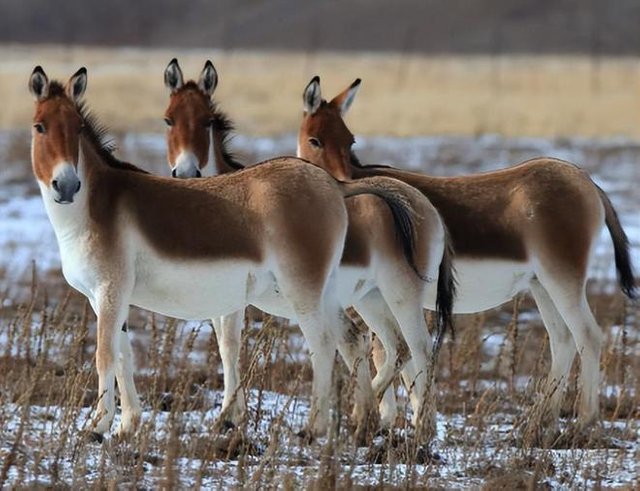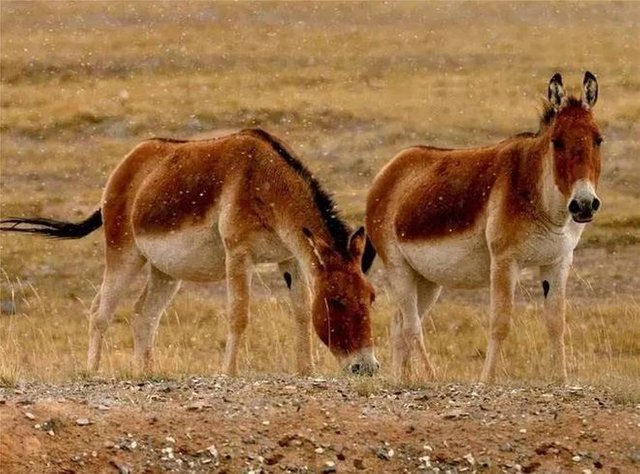非洲野驴的生活习性 +Habits of the African wild donkey
- 栖息环境
非洲野驴主要栖息在干旱和半干旱的草原、荒漠以及半荒漠地区。这些地方植被相对稀疏,有一些耐旱的草本植物和灌木丛,例如在撒哈拉沙漠的边缘地带,非洲野驴能适应那里少雨、高温的恶劣环境。它们对水的依赖性不像其他一些动物那么强,这得益于它们出色的耐渴能力 - 食性特点
- 非洲野驴是草食性动物,以各种草本植物为食。它们的食物包括沙漠中生长的骆驼刺等多刺植物,还有像狗尾草之类的常见草本。由于生活环境中食物资源有限,它们进化出了能适应粗劣食物的消化系统。它们在清晨和傍晚比较活跃,这个时候温度相对较低,它们会花费大量时间寻找和进食食物。在干旱季节,食物匮乏时,它们会扩大觅食范围,甚至能凭借记忆找到一些隐藏在沙地或岩石缝隙中的植物。
- 活动规律
- 非洲野驴多在白天活动,不过在炎热的中午,它们会寻找树荫或者岩石的阴影来躲避高温。它们具有很强的奔跑能力,这不仅有助于它们在广阔的栖息地内寻找食物和水源,还能躲避天敌。它们的奔跑速度相当快,时速可达70公里左右,而且耐力很好。它们通常以小群体形式活动,群体数量一般在5 - 20头左右。这些群体主要由一头成年雄性带领,成员之间会通过声音和身体语言进行交流。
- 繁殖习性
- 非洲野驴的繁殖季节通常取决于当地的气候和食物资源情况。在食物相对丰富的时候,雌性非洲野驴会进入发情期。妊娠期大约为11 - 12个月,每胎通常产1仔。幼驴出生后很快就能站立和行走,这是它们为了在野外环境中生存而进化出的本能。幼驴在群体的保护下成长,雌性野驴会悉心照顾幼崽,教它们识别食物、水源和躲避危险。在幼驴成长过程中,群体中的其他成员也会发挥一定的保护作用。


Habitat
African wild donkeys mainly inhabit arid and semi-arid grasslands, deserts, and semi-desert areas. The vegetation in these places is relatively sparse, with some drought-tolerant herbaceous plants and bushes. For example, in the areas on the edge of the Sahara Desert, African wild donkeys can adapt to the harsh environment with little rain and high temperatures. They are not as dependent on water as some other animals, thanks to their excellent ability to endure thirst.Feeding Habits
African wild donkeys are herbivores and feed on various herbaceous plants. Their food includes thorny plants like Alhagi sparsifolia growing in the desert, as well as common grasses like Setaria viridis. Due to the limited food resources in their living environment, they have evolved a digestive system that can adapt to coarse and inferior food. They are more active in the early morning and at dusk when the temperature is relatively low. They will spend a lot of time looking for and eating food. During the dry season when food is scarce, they will expand their foraging range and can even find some plants hidden in sandy areas or rock crevices by memory.Activity Patterns
African wild donkeys are mostly active during the day. However, in the hot noon, they will look for the shade of trees or rocks to avoid the high temperature. They have a strong running ability, which not only helps them to find food and water within their vast habitats but also enables them to escape from predators. Their running speed can reach about 70 kilometers per hour, and they have good endurance. They usually live in small groups, with the group size generally ranging from 5 to 20 individuals. These groups are mainly led by an adult male, and the members communicate with each other through sounds and body language.Reproductive Habits
The breeding season of African wild donkeys usually depends on the local climate and food resources. When food is relatively abundant, female African wild donkeys will enter the estrus period. The gestation period is about 11 to 12 months, and usually one foal is born at a time. Newborn foals can stand and walk quickly, which is an instinct they have evolved for survival in the wild environment. Foals grow up under the protection of the group. Female wild donkeys will take good care of the young, teaching them to identify food, water sources, and avoid danger. During the growth process of the foals, other members of the group will also play a certain protective role.